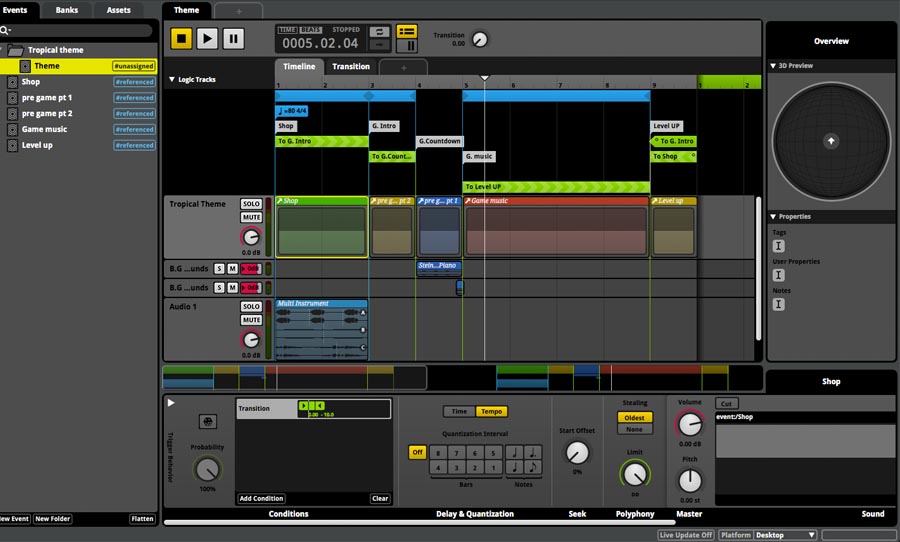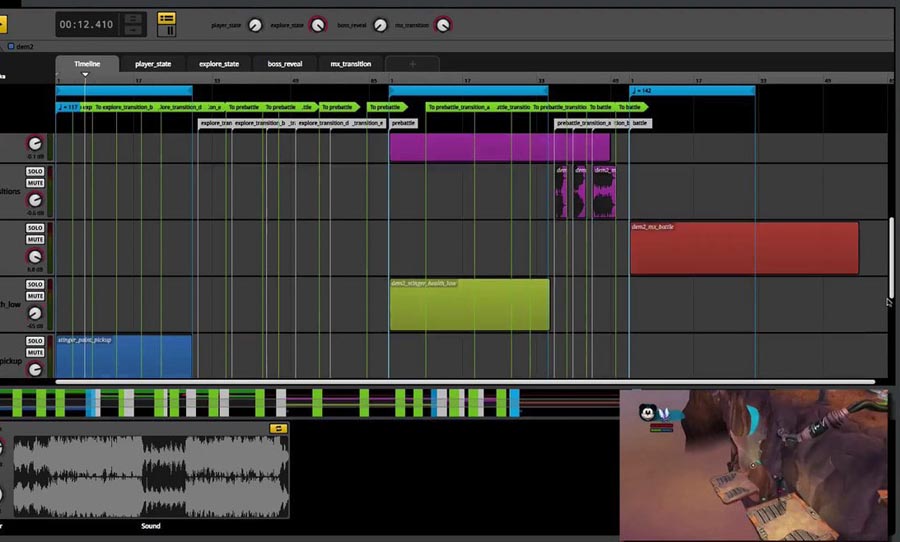Like its slightly more established rival, Wwise, FMOD is a middleware, designed to bring audio into video games. This can take the form of sound effects like foley — which can bring realism to the movements of characters and surfaces with which they interact; and music — to help create the intended underlying atmosphere.
Most importantly, however, FMOD is especially adept at implementing adaptive audio in video games. Adaptive audio is the collective world of sounds that are tied to the action in the game. The same could be said about movies, of course, but the composition and implementation processes are quite different.
So let’s explore the techniques for adaptive soundtracks, how they differ from other forms of scoring for the screen, and how FMOD can bring it all together.
FMOD is the master of adaptive audio for games. Let’s explore some of the techniques behind this form of composition and the tools the FMOD has to make it possible.
It’s no film score
As mentioned before, film scoring and game scoring might have similar emotional impacts on the viewer and player, but it’s achieved in different ways. In the process of film making, composing the soundtrack usually doesn’t happen until after the film has been edited.
The composer has a screen-locked version of the film, therefore, they can synchronise the musical events down to the millisecond, safe in the knowledge that things won’t be altered afterwards. Of course, there are many exceptions to this rule, leading to many last-minute, hair-raising rewrites, but the principle remains. In gaming, it’s an entirely different method.
While film scores may not make complete sense as a discrete piece of music, they can at least be experienced in a linear way. Game music composition, alternatively, can be thought of as a collection of layers that relate cohesively to each other but aren’t hemmed in by traditional notions of structure and time.
“The music, when I write it, is in a massive Ableton session. These sessions once laid out can be an hour long, for example, and this includes everything that the player might go through during that level“, says Mick Gordon, the composer for DOOM Eternal, “What you end up with is not a song, but you have this massive – I don’t know what it is – like a library of music for that level. You can’t just hit play and listen through it from start to finish.”
Adaptive environments
The music in a game is a dynamic beast, controlled by the actions of the player. One such technique for creating differences in the game’s atmosphere is ‘simultaneous variation’ – which can be facilitated within the FMOD environment.
For instance, you might have a static loop when the character in a game is in a relaxed state. When the character approaches danger, the music should escalate. And when they enter a battle, it should escalate further and so on. To flip from one piece of music another abruptly would be too distracting for the player. The transition should be gradual, yet sudden enough to signal a dramatic change in mood.
Simultaneous variation is a classic technique that is made easy by FMOD’s DAW-like workflow and user interface. Crossfade parameters can be set up and linked to a character’s action or proximity to a particular environment in order to create a seamless change in mood.
Looping is an essential technique for adaptive audio and FMOD provides intelligent ways to incorporate it into your workflow. For example, when a character enters a certain zone, you might want the music to loop statically. Then, when the character moves to a different environment, it could be desirable for the music to change. In FMOD, you can link looped sections to particular locations, so the music can adapt.
Similarly, but slightly more complicated, are transition markers. These markers can trigger jumps in the soundtrack’s location. If there’s a sudden escalation or de-escalation in action, or even escaping to a pause screen, the transition markers FMOD are your best friend.
The term ‘transition’ is particularly apt here. Not only can you jump to incongruous sections of music, it can do it smoothly, so as not to take the player’s mind away from the action. Ableton Live users will understand what’s going on here.
One of the most musically intuitive aspects of Live’s clip view is subdivision transitions between scenes. If you want to trigger a new section of a song, you can set the transition period for a period that makes musical sense — one bar for example. The transition markers in FMOD work in the same way. If a character escapes from danger and emerges in an environment of relative tranquillity, the music can transition to suit, while still maintaining cohesion as a musical whole.
These features and a host of others make FMOD an enticing prospect, especially if you come from a background of DAW-based music production. And if you are thinking of dipping your toes into the epic world of video game soundtracks, FMOD has the tools to make the composition process fun and intuitive.


